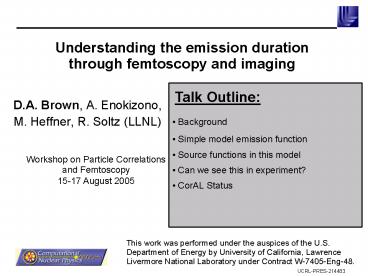Understanding the emission duration through femtoscopy and imaging - PowerPoint PPT Presentation
Title:
Understanding the emission duration through femtoscopy and imaging
Description:
UCRL-PRES-214483. Understanding the emission duration through femtoscopy ... Developed on MacOS X, linux, cygwin. Time scale for 1.0 release: end of summerish ... – PowerPoint PPT presentation
Number of Views:34
Avg rating:3.0/5.0
Title: Understanding the emission duration through femtoscopy and imaging
1
Understanding the emission duration through
femtoscopy and imaging
- D.A. Brown, A. Enokizono,
- M. Heffner, R. Soltz (LLNL)
This work was performed under the auspices of the
U.S. Department of Energy by University of
California, Lawrence Livermore National
Laboratory under Contract W-7405-Eng-48.
2
Mikes HBT Puzzle 1
- What does QGP do to HBT radii? (Rischke, Gyulassy
Nucl. Phys. A 608, 479 (1996), many others) - If there is a phase-transition, hydro evolution
will slow in mixed phase. - Will lead to long-lived source
- Huge difference in Outward/Sideward radii
3
The Koonin-Pratt Formalism
Source function related to emission function
We work in Bertsch-Pratt coords., in pCM
4
Our coordinate choice
Work in Bertsch-Pratt coordinates in pair CM
frame
Boost from lab ? pair CM means lifetime effects
transformed into Outwards/Longitudinal direction.
5
Core Halo Model
Nickerson, Csörgo?, Kiang, Phys. Rev. C 57, 3251
(1998) other papers
f is fraction of ?s emitted directly from core,
effectively ?? f2 in source function
6
Core Halo Model, cont.
- From exploding core, with Gaussian shape
- Flow profile simple, but adjustable
- From decay of emitted resonances, ? has most
likely lifetime (23 fm/c) - use full 3-body
decay kinematics
7
Simple Model, Interesting Results
Set RxRyRz4 fm, ?f/o10 fm/c, T175 MeV, f0.56
8
Focus on Outwards Direction
9
Focus on Outwards Direction
Gaussian RO fits Baseline 5.63 Instant
f/o 4.78 No ? 5.35 No lifetime 4.48 ?max0.35
6.51 radii in fm, fit w/ rlt15 fm, fit
tolerance 1
10
Focus on Sidewards Direction
11
Focus on Longitudinal Direction
12
Take Home Messages from Model
- Need emission duration particle motion to get
lifetime effect - Finite lifetime can create tail, w/o changing
core radii substantially - RHIC HBT puzzle 1 could be Gaussian fit missing
tail from long lifetime - Resonance effects detectable, but similar to
freeze-out duration effects - Maybe need to image 3d kaon correlations to
observe system lifetime determine whether f/o
is sudden or not - Dont be fooled by acceptance effects
13
Warning You are about to see preliminary plots!
14
Correlations from Baseline model
Used S. Pratts CRAB code
15
Breaking Problem into 1d Problems
Expand in Ylms and Legendre polynomials
16
What do the terms mean?
- l 0 Angle averaged
- correlation, get access to Rinv
- l 1 Access to Lednicky offset,
- i.e. who emitted first (unlike only)
- l 2 Shape information
- access to RO, RS, RL
- C20 ? RL
- ?C00-(C20C22) ? RS ,RO
- l 3 Boomerang/triaxial
- deformation (unlike only)
- l 4 Squares off shape
17
Baseline models terms
did not image l4 terms yet
18
Imaging Summary
- Use CorAL version 0.3
- Source radial terms written in Basis Spline
representation - knots first set using Sampling Theorem from
Fourier Theory, then we optimize them to get best
c2 - use 3rd degree splines
- Use full Coulomb wavefunction, symmetrized
- Use generalized least-square for inversion
- Use constraints to stabilize inversion
- Cut off at finite l, q in input correlation
19
Terms in imaged source
knots too close, causes cusp when reassembled.
Is clearly an artifact
20
Reassembled imaged source
- Cusp really bad
- Tail hard to resolve
- Gaussian fit actually not bad for core
- lm00 term needs a lot of tuning (c2/ndf8.4)
21
Imaging tails in 3d is hard
- Not shown images of other test cases --
unfortunately they dont look much different from
baseline model, yet - This is just first pass at imaging these test
models, there is a lot of tuning to do - finer q bins in correlation help a lot
- need those l4 terms
- better statistics in model might help
- newly coded optimal knot algorithm needs work
- Can we get the tails time constant from the
images? Not easily, Rhalo vt, but lots of
different vs comprise same source.
22
CorAL Features
- Variety of kernels
- Coulomb, NN interactions, asymptotic forms
- Any combination of p, n, ????, K-, ?, plus some
exotic pairs - Fit a 1d or 3d correlation w/ variety of Gaussian
sources - Directly image a correlation, in 1d or 3d
- Build model correlations/sources from
- OSCAR formatted output,
- Blast Wave,
- variety of simple models
- Build model correlations/sources in Spherical or
Cartesian harmonics
23
CorAL Status
- Merging of three related projects
- original CorAL by M. Heffner, fitting
correlations w/ source convoluted w/ full kernel - HBTprogs in 3d by D. Brown, P. Danielewicz,
imaging sources from correlation data w/ full
kernels - CRAB () by S. Pratt, use models to generate
correlations, sources w/ full kernels - Rewritten in C, open source, nearly stand
alone (depends on GSL only) - Developed on MacOS X, linux, cygwin
- Time scale for 1.0 release end of summerish
24
Extra Slides
25
Representing the Source Function
Radial dependence of each term in terms of Basis
Splines
26
The inversion process
Koonin-Pratt eq. in matrix form
27
Constraints for 3d problem(s)
Inversion can be stabilized with constraints.
Constraints we use































